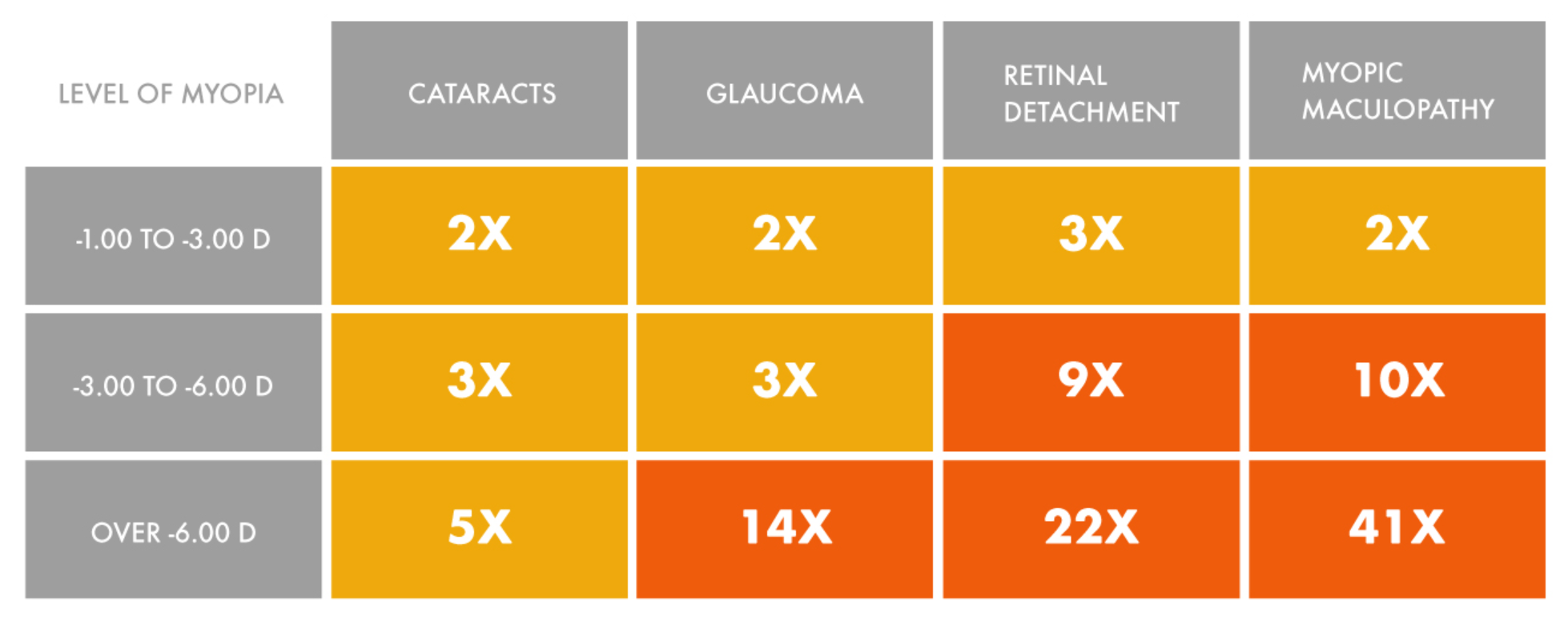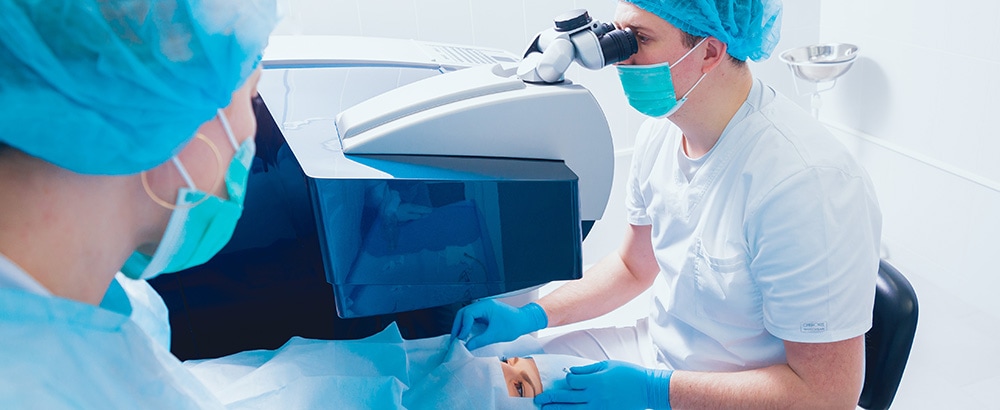Parents often have questions when deciding whether or not to do myopia control lenses such as MiYOSMART 新乐学 or Stellest 星趣控 for their child. In today’s article, we are going to talk about the common concerns we often hear from parents about myopia control and why should your myopic child start myopia control now.
Will myopia cause blindness
The higher the myopia, the higher the risk of your child developing eye complications such as retinal detachment and cataract which can cause blindness if left untreated.
The table below shows the risks of your child developing eye complications as their myopia gets higher.

With myopia control lenses slowing down your child’s myopia progression, your child’s final myopia in the future may be lower which reduces their risk of developing eye complications.
Wearing glasses will cause myopia to increase
Not wearing glasses does not stop your child’s myopia progression, but can also increase the rate of myopia progression.
Studies have shown that 80% of the learning occurs through vision and 1 in 3 children can’t see the board clearly. Without vision correction, your child will experience blurriness which can put him in a disadvantage when learning. It can also cause the eye to grow longer faster, resulting in faster myopia progression.
Myopia control lenses are expensive
Regular single vision glasses are slightly cheaper than myopia control lenses because it does not slow down myopia control. However, if you think in a long run, you might end up spending more for frequent replacement as myopia progression faster and more costly glasses due to higher myopia. Whereas for myopia control lenses, your child might not need to change glasses as often.
An optical chain store in Singapore is offering your child ( 12 years and below) a change in lenses ( normal prescription lenses ) within a year if you purchase from them. As seen below, your child’s myopia will most likely increase if he / she has myopia at a younger age. Their prescription can increase as much as 200 degree (2.0 diopter) per year .
If your child is 100 degree (-1.00 D) when wears a myopia control spectacle lens like Miyosmart or Stellest, his prescription may just go up to -1.50 after one year instead of -2.00 D or -2.50 D.
So which is better? Spending a bit more now to stop the progression of your child’s myopia or saving some money but putting your child at risk of becoming more myopic ?
Normal glasses are good enough for my child’s myopia
Normal single vision glasses / contact lenses can help to correct myopia but does not slow down your child’s myopia progression. Hence, when your child grow up, their myopia might progress faster and results in high myopia in the future.
The graph (using BHVI Myopia Calculator) below shows an estimated refractive error of a 6 year old child with myopia of -1.00D with and without myopia management:

With myopia management, the child’s resultant myopia is lower than without myopia management. Hence, regular glasses / contact lenses are not good enough to deal with myopia.
What if myopia still increase after wearing myopia control lenses
Your child’s myopia will increase because your child is still growing. However, with myopia control lenses, the rate will be slower. Depending on your child’s age and lifestyle, the rate of myopia progression is different. For example, your child might be have myopia progression of -1.50D per year. However, with myopia control, the increase might only be -0.75D to -1.00D ( assuming 50% effectiveness )
I will monitor my child first
Some parents asked whether they should put their child on regular glasses and monitor the myopia progression for a year before deciding whether it is really needed for their child to get myopia control lenses. This is usually not recommended because during the monitoring period, your child’s myopia will most likely increase, contributing to his final myopia in the future.
My child can do LASIK in the future
When your child is myopic, his eyeball is longer than a child who has perfect eyesight. This will results in higher risk of eye complications in the future. Instead of reversing myopia, LASIK reshape the front part of the eyes. The back part of the eyes still remains the same. Hence, the risks of developing eye complications still remain the same.

Is it too early to consider myopia control lenses
It is not early to consider myopia control lenses for your myopic child. According to studies, myopia progression is the fastest at age 7-8 years and usually stabilize at around age of 20. The earlier your child develops myopia, the more years it has to progress, the higher the myopia will becomes in the future.
The table below shows the myopia at 16 years old when the child who develop myopia at 7 years old vs at 11 years old.

If your child has myopia of -1.00D at 7 years old, it might develop into -6.00D by 16 years old.
1 year Unlimited exchange of lens program
We noticed that a certain chain store is promoting the above, with the promise that your child can change their lenses unlimited number of times withing a year when their prescription changes. This may seem like a good deal as you get to save a lot of money.
They mentioned that “as children grow their eyesight is also changes frequently” . The thing is , their eyesight don’t change frequently but their myopia keeps increasing. Instead of managing the myopia progression, nothing was done to address the “frequent eyesight changes “. Which makes more sense to you: free lens changes for a year but your child’s myopia shot up by 200 degrees / year . Or put your child in myopia management program and one year later your child’s myopia only progress by 100 degree or less ?
Start myopia control early
The higher the myopia, the higher the risk of your child developing eye complications in the future. Starting myopia control early allows your child’s final myopia in the future to be lower which can reduce their risks of developing eye diseases.
Click here to read more about myopia control lenses.
Book an appointment with our optometrists now ! Or you can WhatsApp +6588461234 to find out more.
Written by JH Tan, edited by Winston
References
- Patient Management in Myopia Management. 2021. Essilor.

